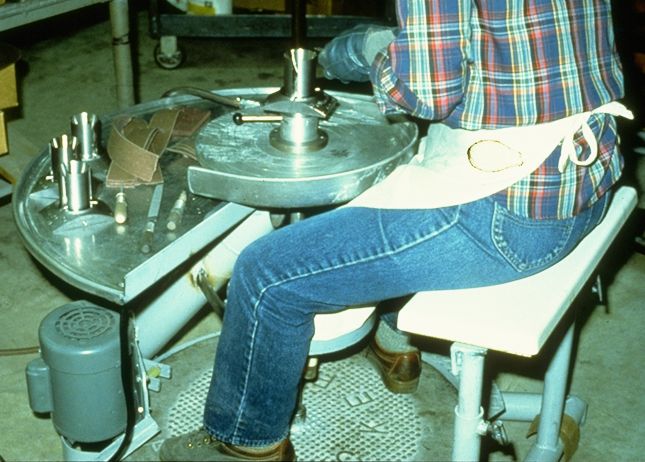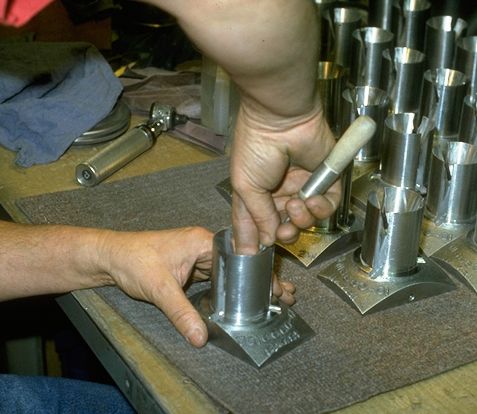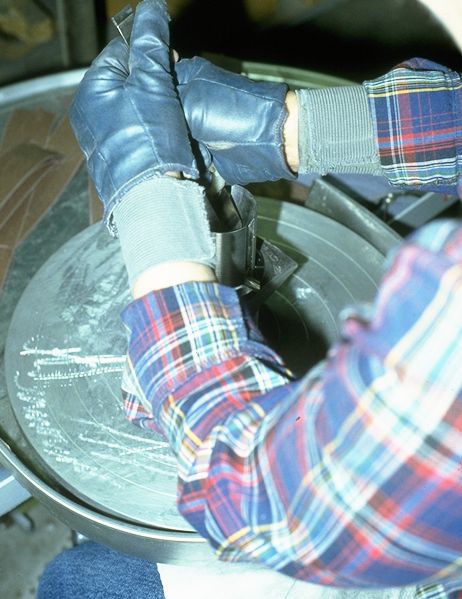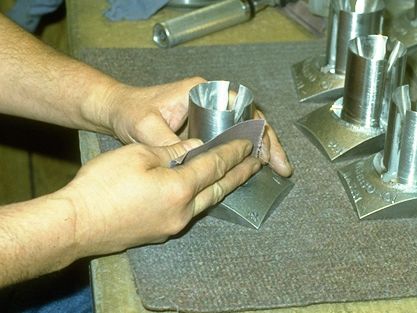The Potter's
Wheel
4000
year-old technology solves injury problem, increases
output 20%, and eliminates rejects.
Dan MacLeod
www.danmacleod.com
January 10, 2006
An informal discussion with employees at this plant revealed the task
that they considered the most difficult: deburring the “Slotted Pole.” Consequently, one of the plant engineers
and I focused on this
task.
The Slotted Pole was a cylinder about five inches long mounted on a
stubby base. The inside of the cylinder was somewhat hollow,
with three slots trisecting the part most of its length, hence its
name. The job was to take the parts that had been recently
machined and remove burrs and sharp edges. Because the part was
to go into a mainframe computer, all slivers of metal had to be
removed completely and the rough surfaces polished. Quality
requirements were extremely high, since the slightest fleck of metal
could ruin an entire computer.
The
task of deburring the Slotted Pole was unpopular. Consequently a
variety of people had been trained to do the work and rotated through
the job to spread the burden equally.

Issues: Using the left hand as a fixture;
right hand pinch grip
One
part of the task consisted of holding the part in the left hand and manipulating
it, while the right hand performed various motions such as sanding the
part’s edges and surfaces. As shown in the photo, the
sandpaper was held in an awkward “pinch” grip with fingers extended to
reach the inside of the part, thus creating high compression forces on
the right hand wrist. However, the employees stated that the worst
part of the task was with the left hand — the continuous gripping
(“static load”) and constant manipulation of the part.
Lesson 1: It is vital to talk to the employee in order to
learn about the job and gain insights into problems and solutions.
Some details can be gained in no other way.
Lesson 2: Using the non-dominant hand as a “fixture” is a
common source of musculoskeletal disorders. This is important
because there is a natural tendency to focus on the hand doing the work
to the neglect the hand
manipulating the product.
Lesson 3: Often, the specific problems of a job can be
identified relatively easily, and without need for measurements or
elaborate studies. Typically the difficulty is the next step: finding solutions.
Based on this assessment and other observations, the engineer and I
brainstormed options for improvement, and from time to time floated
ideas past the employee and supervisor of the area. The first goal
was to fixture the part to relieve the left hand from the constant
gripping forces. The fixture needed to rotate, however, to
accommodate the need to access the part in different orientations.
Initially, we considered a simple “Lazy Susan” fixture. However,
we became concerned that the need to continuously rotate the fixture
manually with the left arm would merely transfer the problem to the elbow and shoulder.
Consequently, we thought of the idea of powering the fixture.
But we eventually discarded this idea too, since the “Slotted Pole” needed
both to be rotated continuously and at varying speeds to sand the
outside surface and then indexed rather precisely at one-third turn
intervals to access the slots correctly. A power mechanism to
accomplish both requirements would cost too much, particularly in development time.
Our brainstorming then refocused on the Lazy Susan, with the added idea of
running a shaft from the rotating fixture on the workbench down the
floor where it could be easily manipulated by the feet. As the
engineer and I began to sketch the needed device, it finally dawned on
us
that a similar device had been invented long ago and was readily
available. We had just reinvented the potter's wheel.

The
Potter’s Wheel ─
4000-year-old technology used to solve a problem in making mainframe
computer parts.
Note the fixture on the plate (where the potters would normally work
the clay), the kick wheel, the electric motor, . .
. and the inadequate seat.
So, the
company purchased and installed a potter’s wheel. We used
technology that was 4,000 year old to solve a problem in a plant that made
computer parts. There were many features of the potter’s wheel that
could be applied to this task. The potter’s wheel had a plate,
normally used to support the potter’s clay, onto which a fixture to
hold the Slotted Pole was attached. The shaft that connected the
plate (and now fixture) to the wheel beneath could be manipulated
easily by the feet, both to rotate evenly at varying speeds and to
index precisely.
This
off-the-shelf device worked successfully and served as the basis for
further refinements. Specifically, the fixture eliminated all of the
repetitions and exertion of one hand in manipulating the part (thus,
in one step, reducing the overall wrist stress by 50%).
Lesson 4: Anything which solves a problem is ergonomic — the
solution does not need to be a device normally thought of as an
“ergonomic” product.
Lesson 5: The problem-solving process need not elaborate or
highly technical. Creative thinking is often more important.
Lesson 6: Unconventional, “hare-brained” ideas often lead to
good results. Solutions can be found in many areas, even from
equipment not normally associated with the industry in question.
Lesson 7: Fixtures, where feasible, can be quite effective in
reducing stress on at least one hand.

Deburrer’s Knife ─
Issues: Inadequate grip for right hand (not being used at all);
awkward wrist and arm posture; and once again using the left hand as a
fixture.
Another part of the task involved use of a generic “Deburrer’s
Knife.” As shown in the photo, this knife was used to reach
deep into the center of the cylinder to scrape out burrs. The
photo shows several other issues. One is the awkward postures
of the wrist and elbow, both contributors to musculoskeletal problems.
Another issue is the grip of this generic device, which was so
inadequate for the task that it was not used at all. Finally, the
illustration once again shows once again the problem of using the
non-dominant hand as a fixture.

Home-made, two-handed knife
Once
the part was attached to a fixture, then the left hand became
available to help manipulate tools. In this case, a special
two-handled tool was designed specifically to reach into the slots to
scrape out burrs. The tool could simply be inserted into the slot and
pulled, providing three great benefits: (a) the tool placed the
wrists and elbows in much better posture, (b) it divided the force
between both hands and (c) took advantage of the larger muscle groups
in the upper arms and even shoulder and torso.
Lesson 8: Once a product or part is fixtured, it opens the
door to two-handed tools, which usually are both easier to manipulate
and distribute force to more (and often larger) muscle groups.
Lesson 9: Dedicated tools — designed to accomplish a single
task — are often better than generic tools.

Hand sanding ─
Issues: repetitive right shoulder motions; right hand pinch grip; left
hand as fixture.
A
further problem in the original task was sanding the outside surface of the
part. Considerable repetitive, rather forceful motions of the
right arm were required
to perform these actions. Once again, the left hand was used as a fixture
in doing this step of the job.

Hand sanding with electric motor. Note
the pinch grips to hold the sandpaper, but the force was light and of
short duration..
Fortunately, the
potter’s wheel that the company bought was the high end of potter’s wheel
design and came equipped with an electric motor to spin the wheel.
Thus, the employee could turn on the motor to spin the wheel, in
addition to moving the part slowly by manipulating the feet.
With the motor on, the employee
could simply hold a piece of sandpaper rather loosely to the part and
it would be polished quickly and cleanly with little physical effort.
Lesson 10: Reducing repetitive motions does not necessarily mean slowing
the job down. On the contrary, with good design, the task can be
completed faster, but with less manual movement.

Modified Potter’s Wheel.
As
experience was gained with the potter’s wheel, a variety of
modifications were made. The plate (to support the potter’s clay) was
removed, since it had no function anymore. The fixture was angled
with the use of a gearbox to orient the Slotted Pole to the employee
for improved access. A storage area that was part of the original
equipment, but a bit out of reach, was raised up and moved closer. A
task light was added. The original potter’s stool, which had no back
support and lacked cushioning for the seat, was replaced with a car
seat, equipped with an electric motor to provide adjustment for
varying length legs.
Lesson 11: Continuous improvement applies to ergonomics as much as
to any other aspect of the workplace. There is no final ergonomic fix
— there are always ways of improving equipment.
Two
additional items of special note also evolved. The first involved an
additional problem with the initial potter’s wheel design. Once the
wheel was spinning, there was no way to stop it quickly. Potters had
no particular need to stop the wheel as abruptly and frequently as did
these deburring employees.
The
solution involved the plant maintenance man, who in the course of
events had become actively engaged in redesigning the potter’s wheel.
He happened to be a Harley-Davidson enthusiast and had a supply of
spare motorcycle parts available. To stop the wheel, he attached a
Harley-Davidson brake, complete with foot pedal that stood out
conspicuously to one side — large and chrome-plated.
Lesson 12: Everyone can make a contribution. Maintenance
personnel, once provided with the principles of ergonomics and the
goals of the program, can be especially gifted in making creative
improvements.
One
previous occasions, the supervisor had encouraged the employees to use
various powered deburring tools that were available. However, the
employees resisted, stating that the powered tools were awkward to
use. As it turned out, once the employees began to use the potter’s
wheel, they also began to use the power tools successfully.
Apparently, the employees had become so used to doing the task in a
certain way, that any change, even ones that were seemingly
beneficial, seemed awkward. However, once the entire task was
disrupted and whole new techniques needed to be learned, the employees
were able to incorporate the power tools.
Lesson 13: Incorporating change can be difficult for a variety of
reasons, one of which is the chore of learning a highly refined work
technique all over again. Sometimes it is easier to make a big change
than a little one.
Results for Potter's Wheel
-
Injuries — Ultimately, the number of MSDs related to this job dropped
to zero.
-
Quality — Rejects also dropped to zero, since the Potter's Wheel
enabled the employees to do their jobs better.
-
Productivity — Output increased 20%.
Improving other deburring tasks
After the initial changes was made on the Slotted Pole, attention
shifted to other tasks, again involving employees and brainstorming
improvements.
Most
other deburring tasks involved working on large, traditional work
tables. Employees often worked hunched over these tables, with poor
back and neck postures. The work benches were fixed-height and could
not be adjusted for taller workers. Moreover, since two or more
people typically worked at each table, the tables could not
accommodate everyone easily, even if they had been adjustable. An
additional issue was that the employees stood all day on a concrete
floor. Finally, other issues were that there no particular place
provided for tools, plus occasional long reaches to obtain needed
tools and equipment.


“After” work bench: At left, the
die cart. At right, a tall worker has raised the die cart six
inches above the old table (at his immediate left). Note the use
of the foot rest.
The
first decision was to procure sturdy, adjustable-height work tables.
However, none could be found on the market when this case study
occurred in 1987. Happily, once again with creative thinking, an
off-the-shelf product — originally intended for another purpose — was
modified for use, rather than constructing a suitable table from
scratch.
The
item purchased was a standard industrial die-cart — designed
originally to lift heavy dies into presses — that had many of the
features needed, particularly height-adjustment and a sturdy base. It
was modified in several ways. A one-quarter inch sheet of plastic was
attached to the top surface to provide more of an appearance of a work
table and to protect tools and parts from the steel. Brackets were
mounted to the sides of the table to hold tools, fixtures and a task
light.
Used
as a work station, these carts could readily be raised and lowered to
adjust for individual height. Furthermore, the die cart had several
additional features which unintentionally came into play:
-
The base of the cart served well as a foot rest, whether
sitting or standing.
-
The dimensions of the top work surface was small, only
about three feet wide and two feet deep — quite sufficient for the
task at hand. The unintended benefit was that once all employees were
equipped with these tables and the old, larger tables discarded,
considerable floor space was gained. A previously congested area
became rather roomy.
-
The die carts came with wheels, since they needed to be
moved about in their original application. These new work stations
were thus mobile and could be used as the basis of a modular, flexible
manufacturing system. The engineers created several work cell areas
using pedestals attached to the floor and equipped with electric
outlets and pressurized air couplings. Employees then wheeled their
workstations to the appropriate cell, hooked up and worked as a unit
on a particular part. As production required, they shifted quickly
from one cell to another.
-
These individual workstations could be personalized for
each employee to promote an individual’s own identity.
-
Finally, the work stations were designed for standing height, and tall
stools provided to permit employees to sit or stand as they chose.
The stools themselves adjustable and had other ergonomic features.
Anti-fatigue mats provided for when standing.
Lesson 14. Once each employee is provided with an individual
workbench, then individual adjustment becomes feasible.
Lesson 15. There were unanticipated other benefits. Many tasks do
not require the space allotted to them. Workbenches and desks are
often designed to be large for no reason other than status, and they
merely serve to collect clutter.
Overall Results
Injuries dropped dramatically for the whole
facility and workers' compensation costs were cut by 90%.
Overall costs of the project totaled about
$20,000 for new and modified equipment. Savings from workers'
comp reductions were about $100,000, a 500% return-on-investment in
one year.
Postscript
After a time, the engineers in this facility began thinking about deburring in a way in which they had not previously.
Subsequently, they found ways to improve machining capabilities to
reduce the burrs and thus eliminated much of the need for deburring
altogether.
Lesson 16. Often, just getting people to think about a problem,
perhaps presented in a new way, can be sufficient to induce them to
apply their usual skills in solving problems. Extensive training in
the details of ergonomics or complicated task analysis may not be necessary.
Lesson 17. One should not neglect the root cause of the problem.
Don't fix tasks that shouldn't be done in the first place.
|
